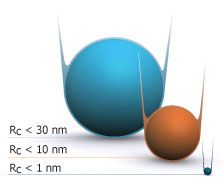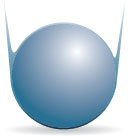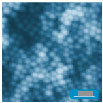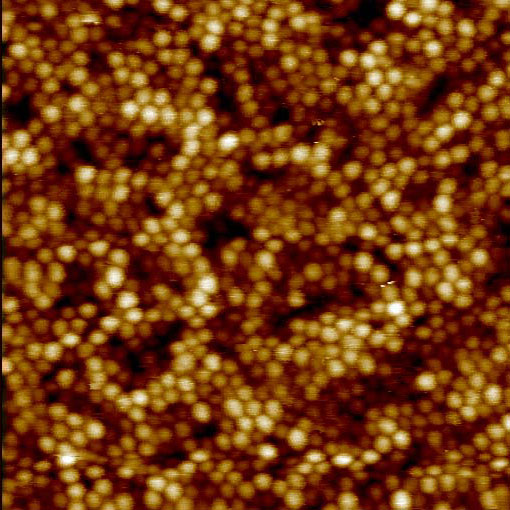
Suppose there are three AFM probes available for imaging: a hardened AFM probe with R <30nm, a standard tapping mode AFM probe with R <10nm and a high resolution AFM probe with R ~1nm. Which of the three AFM probes should be chosen to get enough resolution?
One way of describing resolution is to consider whether two adjacent objects can be resolved by a particular AFM probe. If we have two rigid spikes and a 0.1nm detector sensitivity in the z-direction, then the minimum diameter between these spikes for the AFM probe to distinguish between them is d=(0.8R)1/2, where d is the distance between the spikes and R is the radius of the AFM tip.
The amount of lateral resolution required should also be considered. Is it necessary only to know that there are two objects present? Or is it important to have the accurate lateral dimensions of these objects? The larger the radius of the AFM tip and the larger the opening angle of the AFM tip, the greater convolution will be present in the lateral dimensions. This effect has a greater impact on the accuracy of the dimensions of smaller objects than larger ones. For two spheres, the distance separating them must be d=4(Rr)1/2, where r is the radius of the spheres, in order for the AFM tip to fully probe between them. δr=(d-r) is also the lateral distance that will be "added" by the size of the tip to the sphere's topography.
Step size, which is the ratio of the scan size and the number of sampling points, should be also taken into account.
Let's consider the case of imaging the topography of very small spheres 4nm in diameter. The choice of the AFM tip and the scan size will determine if the spheres can be resolved. There are different possibilities:
Hardened AFM probes with large tip radii have been mostly used for accurate measurement of vertical dimensions of rigid samples, lateral information for large features, or for when accurate lateral measurements are not important. These AFM probes are especially durable, allowing many more scans to be taken without a loss of resolution or damage to the AFM tip.
Standard AFM probes with R<10nm provide additional resolution in the lateral dimension and are good for getting good quality everyday images of large and small features.
Because the Hi'Res-C AFM tips have a very sharp AFM tip and a high aspect ratio geometry, the convolution in the lateral dimension is minimized. Hi'Res-C AFM probes should be used when the best lateral resolution is necessary or when the feature size is exceptionally small.
AFM Tip Size
|
Scan Size
|

Rc <30nm
HARDENED |

Scan size 3µm. Diameter of spherical
molecules 150nm. Click to enlarge. Height
image of polystyrene latex spheres.
/Courtesy of S. Magonov/ |

Rc <10nm
STANDARD |

Scan size 800nm. Diameter of spherical
molecules about 40nm. Click to enlarge.
Composite film of poly(p-xylylene) matrix
and nanoparticles of MoO3 and TiO2.
/Courtesy of R. Gaynutdinov/ |

Rc <1nm
HIGH RESOLUTION |

Scan size 250nm. Diameter of
spherical molecules 9nm. Click to enlarge.
Carbosilane dendrimers in a dense film.
/Courtesy of D. Ivanov/ |










